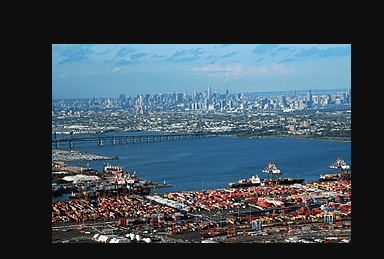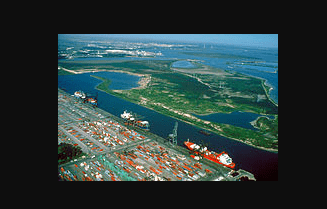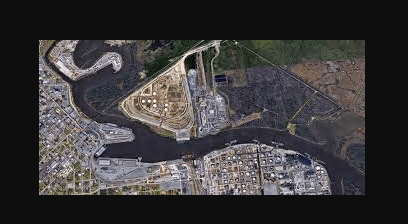
Largest Ports of the United States;-America’s landmass is largely covered by shipping activity from the United States of America. It covers 75% of the shipping of its commodities using maritime lines. In 2019, a record 2363 million MT of cargo was handled in 50 ports around the USA.
Since the early 1600s, the USA has dominated the maritime industry historically. However, starting around 1820, commercial freight operations saw a significant increase.
Since 1952, merchant cargo shipping has seen a steady rise along with the global ascent of the United States. The US brings the North American shipping share to 44% of the global total, along with Canada.
Meanwhile, direct and indirect trade in shipping accounts for 26% of the nation’s GDP. The volume of cargo handled by US shipping increased by 6.9% over the previous ten years.
Among the nations having the largest Exclusive Economic Zone, the United States comes in second place. It has an 11,351,000 square km active zone.
The tonnage of goods handled by 5 major US ports often exceeds three digits (Million MT). In the meantime, 47% of all seaborne cargo is handled by a total of 7 ports.
Today, we examine these seven important ports, their locations, freight trends, and operational tendencies. These facilities collaborate on seaborne trade routes with partners in Australia, Asia, and Africa.
Top 7 Largest Ports of the United States
Port of Houston (Texas, USA)
284.9 million MT of cargo are moved through the port of Houston each year, both within and outside the US. This makes it the busiest port in the nation for handling foreign tonnage. On a global scale, it is also the 10th busiest port facility.
The port was built alongside Houston’s downtown harbor in 1914. The facility currently extends 50 kilometers, all the way to Morgan’s point. Except for South Louisiana, Houston handles 2.5 times more cargo than any other port in the USA.
Handling of Cargo
Every year, seagoing boats make an average of 7,800 to 8,500 calls to the port. Thus, the yearly direct trade value of the operations of this port is $159.8 billion.

There are 2 container terminals, 5 general cargo operating terminals, and a total of 9 public terminals. The waterway has a maximum depth of 11.4 meters and a width of 106.5 meters.
There are six Neo-Panamax cranes and six Post-Panamax cranes used in the Bayport freight operations. A total of 42 RTG, 2 Panamax, 5 Post-Panamax, and 7 Neo-Panamax cranes are in use at the Barbours terminal.
Structure and Network
In terms of carrying containers, the US Gulf line’s Houston port network is the greatest. Additionally, the 52 heavy-lift docks distributed throughout the layout serve a variety of purposes.
More than 200 small and large operators with public and private origins make up the network. The operating facility’s 795,000 jobs are sufficient to meet the port’s operational needs. Cargo is transported over land using vehicles and the intricate Houston rail system.Top 7 Largest Ports of the United States
Port of South Louisiana (Laplace, USA)
Since the 1940s, a cargo operation has operated out of the port of South Louisiana, which has been around since the early 1700s. In terms of overall cargo tonnage measured in million MT, it comes in second place to the Port of Houston. Furthermore, 60% of the Midwest’s grain freight handling is done in South Louisiana.
One of the largest and most extensive ports in the USA, the facility spans a little more than 54 miles. Between New Orleans and Baton Rouge is covered by both ends of its expansion.
The port had 11.9% growth over the previous ten years, a significant figure in terms of its economic contribution to the country. Its proximity to the Mississippi River gives it the US river ports’ highest traffic density.
Handling of Cargo
In the most recent calendar year, 238 million MT of goods were handled at South Louisiana Port. The facility accommodates more than 4000 seagoing vessels annually and has a total of 13 berths available. The available depth for the maximum draft ranges from 13.5 to 15.2 meters in various berths. They combine breakbulk, dry bulk, container, and liquid cargo activities in their cargo handling. 25% of all oil freight that travels across the US is handled by the facility.
Structure and Network
A pipeline service with a length of over 640 miles begins at the superport. 800 barrels of oil are transported via this network from the facility to various locations around the US. This port is connected to every significant location in the US by three major roads (Interstates 10, 55, and 59).Top 7 Largest Ports of the United States
Port of New York, NY, and NJ (New York, USA)
The entire New York Harbour coastline is enclosed by the port of New York and New Jersey. The largest natural harbor in the world, this facility covers a 25-mile radius. With a 640-mile canal surface leading to the complex, it has direct access to the Atlantic.
The keystone and driving force for the increase of inbound traffic to the port is the extension of 1609. However, the main boom began in 1910, making it the busiest port on the planet. It is one of the most profitable ports in the USA with a net annual turnover of $5.5 billion. China accounts for 23.5% of the port’s trade, with India coming in second at 8.1%.

Handling of Cargo
The facility reported handling 136.6 million MT of freight in total in 2019. There are 45 million MT of bulk cargo operations and 41 million MT of general cargo operations. In the same year, the facility handled 7,179,788 TEU in exports and 7,471,131 TEU in imports. A total of 570,023 vehicle units with a 46% US market share also arrived at the site. There are nine ports in all at the site, with quay lengths that can go up to 3087 meters. There are 6 mega berths in all, and the maximum draft for carrying super containers is 15.2 meters.
Structure and Network
The plant is dispersed across a network of 17 counties, with complete control over 10 of them. Thus, it contributes to more than half of.Top 7 Largest Ports of the United States
Also Read;Top 10 Most Valuable and Biggest Companies in the World
Port of CORPUS CHRISTI (Texas, USA)
One of the few ports in the USA having an energy conservation plan is the Port of Corpus Christi. It was founded in 1926 and is the primary terminal for crude oil and natural gas.
Oil-carrying vessels of various sizes are able to approach freely at an average depth of 14 meters. The facility is divided into two sections for side-by-side operations and includes a common storage space of 50 hectares. For seagoing commerce, 6 terminals—the North, South, Liquid, Bulk, RO-RO, and La Quinta—are in operation. The port is the strongest in the Gulf thanks to its 1500 PSI bearing capacity. Military units have been stationed in a portion of the building alongside the US NAVY installation since 1997.
Handling of Cargo
The port moves 100 million MT of cargo on average, with 111 million MT moving through it in 2019. At the oil ports, handling of crude oil and petroleum products accounts for 80% of this. The facility typically receives more than 6500 vessels of all sizes each year. The grain transport elevator includes 36 concrete silos, and a nearby location can store 500,000 barrels. The belts can move more than 1500 MT of dry freight per hour. The gantries, meanwhile, are capable of handling 600 MT each hour.
Structure and Network
Rail ramps are available on the North Terminal Network for direct ro-ro cargo transfer. The strongest open wharf design is dock 8, which is on the Southside. Moreover, the terminal covers 9300 sq. meters of cooling and storage space for delicate cargo handling.Top 7 Largest Ports of the United States
Port of BEAUMONT (Texas, USA)
Since 1908, the port of Beaumont has mostly conducted military operations. However, the facility’s first commercial operations in 1912 were lumber shipments. This facility, which has a 150 sq. mile footprint, generates $2.2 billion in yearly revenue from commercial shipping. It’s one of the few ports in the USA that can accommodate both defense and commercial ships! As a result, it serves as a crucial base for managing and producing commodities for the military.

Handling of Cargo
The facility is located next to the Sabine-Neches Waterway, which serves as the main entry point for US oil traffic. The river transports 14% of the nation’s gasoline freight and 57% of all petroleum cargo. The port’s most recent annual data show 2,070,665 MT of dry cargo.
Structure and Network
Three significant railroad networks, including the Southern and Pacific railway, are connected to the port. As a result, the freight and port operations employ more than 1860 people permanently. The network includes a 600,000 square foot large-scale storage facility for all items.Top 7 Largest Ports of the United States
Port of New Orleans (New Orleans, USA)
Since 1896, the Port of New Orleans has handled maritime traffic across the Mississippi River. It links the coast of America to a vast network of 14,500 miles of commercial waterways. The facility’s freight and rail operations generate over $100 million in profit in turnover.
With an average of 36000 vessel visits every year, it is also one of the busiest ports in the USA. Nearly 41.6% of these vessels transport dry bulk cargo both inbound and outbound. Over 16,000 square meters of space have been put up around the main Avenue complex.
Handling of Cargo
The facility spans a 2000-foot space and contains two significant berths. This configuration covers 65 acres and is designed to accommodate short-term cargo storage. Additionally, 6 gantries are in charge of all procedures including the handling of containers. Additionally, these terminals offer on-dock connectivity via railroad services. The port of New Orleans reported processing 92.2 million MT of cargo in 2019. This also includes domestic bulk freight of 26.9 million MT.
Structure and Network
Internal cargo transport network management is handled by an average of 2,000 trucks. Additionally, the facility offers direct alignment for rail services to offload from deep-sea vessels. The Tier 3 and Tier 1 rail networks are connected to provide continuous transportation around-the-clock. This extends across a 26-mile internal rail network with a 75-mile nodal service.Top 7 Largest Ports of the United States
Port of Long Beach (Ocean Blvd., Long Beach, USA)
In the USA in 2019, the port of Long Beach had the second-largest container handling facility. The facility, which is situated behind its neighbor, the Los Angeles port, currently handles 80–85 million MT. This revealed a 25% growth surge over the previous ten years. For active container operations, a 3.2 km operational region is available. Beginning in 1911, the port began to handle cargo. Currently, it joins with the Los Angeles port corridor to form San Pedro Bay.
Handling of Cargo
The port complex spans full length with 10 cargo piers and a total of 80 active slots. In 2019, these cutting-edge facilities handled 8,113,315 TEU. The container industry’s cargo has an annual value of $56 billion. Container ships can access a depth of 50 feet on average. The largest ship to reach the terminal, meanwhile, had a draft of 20.1 meters. It is one of the few ports in the USA with such high drafts because to these facilities.
Structure and Network
The port and its internal network are connected by more than 100 miles of railway infrastructure for direct handling. This makes it possible to move containers of conventional sizes to ports side by side. The operations for cargo handling and in-port work provide more than 50,000 jobs annually. The second-best reduction in the nation is possible because to the green port policy’s 88% reduction in total emissions.Top 7 Largest Ports of the United States
Frequently Asked Questions
- What are the largest ports in the US?
Port of Los Angeles
The largest port in the USA is the Port of Los Angeles, which is situated on the West Coast of the nation. By even worldwide standards, it transported more than 9.3 million TEUs in the previous year. The port occupies about 8,000 acres of land and runs more than 43 kilometers along the coast.
five U.S. ports
Five American ports have terminals that are owned by state-owned Chinese companies. CMPort owns a small ownership in a French company’s terminals in Miami and Houston, and COSCO has joint ventures in Long Beach, Los Angeles, and Seattle.
- What is the fastest growing port in the United States?
The Port of Philadelphia
The Port of Philadelphia claims to be the port in the country with the quickest rate of expansion. It is the largest refrigerated port in the nation and handles trade worth $30.5 billion annually, helping it to provide more than 54,000 employment.
Be the first to comment